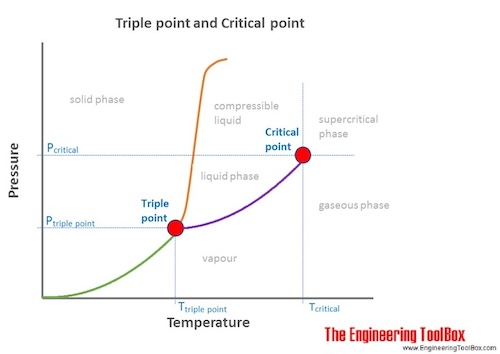Above the Critical Temperature a Substance
Any substance above its critical temperature exists as. In the supercritical environment only one phase exists.

Supercritical Fluid Critical Point Occurs Under Conditions Such As Specific Values Of Pressure And Temperature At Which No Phase Boundaries Exist Therefore Th
The temperature which above a substance can not exist as a liquid no matter how much pressure is applied.

. 728 C 3459 K 4708 atm 4770 kPa Bromine. At the critical temperature they cannot longer be liquified. 100 22 ratings Critical Temperature is defined as the maximum temperature at which a.
At temperatures above the critical temperature the substance in question in its vapourgaseous state can no longer be liquified regardless of the amount pressure applied to it. The temperature above which a substance can exist only as a gas. The correct answer among the choices given is option C.
This fluid is any substance at a temperature and pressure above the critical point here the phases of the liquid and the gas do not exist. The critical temperature of a substance is the temperature above which a substance can exist only in gaseous state. The lowest pressure under which a substance can exist as a liquid at the critical temperature.
1224 C 1508 K 481 atm 4870 kPa Ammonia NH 3 1324 C 4055 K 1113 atm 11280 kPa R-134a. The name associated with the above statement is. C will slowly crystallize into its most stable form.
So this is the definition for the critical temperature of the substance and it is represented by TC. View the full answer. A substance held at a temperature above its critical temperature A always decomposes.
Highest temperature at which the liquid phase can exist in equilibrium with the gas phase. This can be rationalized by thinking that at high enough temperatures above the critical temperature the kinetic energy of the molecules is high enough to overcome any intermolecular forces that would condense the sample into the liquid. The combination of the critical temperature and critical pressure of a substance is its critical point.
A supercritical fluid is any substance at a temperature and pressure above its critical point where distinct liquid and gas phases do not exist. 10106 C 37421 K 4006 atm 4059 kPa R-410A. What is the critical pressure.
The critical temperature of a substance is the temperature at and above which vapour of the substance cannot be liquefied no matter how much pressure is applied ie. Select the correct answer below. The critical temperature of a substance can therefore be defined as the pressure that must be applied to a substance in order.
When one of them is above their critical value it is impossible to change the state of the substance from gas to liquid by merely changing the other parameter. Kridəkəl temprəchər agriculture The temperature below which a plant cannot grow. The critical temperature of carbondioside is 311C.
The critical temperature of a substance can be defined as the highest temperature at which the substance can exist as a liquid. Substance Critical temperature Critical pressure absolute Argon. Any substance above its critical temperature exists as.
If the room temperature is 347C then carbondioxide at room temperature is. Above the critical temperature a substance. Hence Option B is the correct answer.
At the critical point the gas and the liquid phases become identical and the visible boundary between the two phases vanishes. 8 rows The highest temperature of a substance at which it can be condensed and remain in a liquid state. At the highest possible pressure permanently O at no pressure value depends on the substance.
The statement that the entropy of a pure substance in complete theromodynamic equilibrium becomes zero at the absolute zero of temperature is known as. B cannot be condensed at this temperature regardless of the pressure applied. Temperature at which all three phases can exist in equilibrium.
He critical temperature of a substance is the The critical temperature of a substance is the temperature above which the compound decomposes. Above the critical temperature and pressure a substance exists as a dense fluid called a supercritical fluid which resembles a gas in that it completely fills its container but has a density comparable to that of a liquid. If the temperature is below critical temp and the pressure is also below its critical value then there is a possibility that we see an equilibrium between the liquid and gaseous states.
Physical chemistry The temperature of the liquid-vapor critical point that is the temperature above which the substance has no liquid-vapor transition. Above the critical pressure a substance is a supercritical fluid. Every substance has a critical temperature.
Temperature at which sublimation occurs. The pressure exerted by a vapor in equilibrium with its liquid at a given temperature. At temperatures above the critical temperature of a substance it cannot be liquified with the application of any amount of pressure.
3108 C 5840 K 102 atm 10300 kPa Caesium. A supercritical fluid is a substance above its critical temperature and pressure. Solve any question of States Of Matterwith-.
The pressure required to liquify a substance vapor at its critical temperature. D can never be a solid again even after it is cooled. Okay So at the temperature above critical temperature the face of the gas will be face of the substance will be gaseous face only.
A substance can a guest engaged only in Only in guess he is guess heres state. Soobee72pl and 23 more users found this answer helpful. Question Above the critical temperature a gas will liquefy.
What Is Critical Temperature Quora

Critical Temperature Temperature Vs Pressure Graph Examples

Critical Temperatures And Pressures For Some Common Substances
0 Response to "Above the Critical Temperature a Substance"
Post a Comment